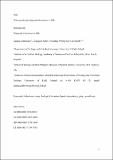Files in this item
The role of intraspecific competition in the dispersal of an invasive fish
Item metadata
| dc.contributor.author | Grabowska, Joanna | |
| dc.contributor.author | Zięba, Grzegorz | |
| dc.contributor.author | Przbylski, Miroslaw | |
| dc.contributor.author | Smith, Carl | |
| dc.date.accessioned | 2020-03-15T00:33:23Z | |
| dc.date.available | 2020-03-15T00:33:23Z | |
| dc.date.issued | 2019-03-15 | |
| dc.identifier | 257592939 | |
| dc.identifier | 71f8766a-bdda-470a-831f-02a99b28d0b4 | |
| dc.identifier | 85062965895 | |
| dc.identifier | 000466805700010 | |
| dc.identifier.citation | Grabowska , J , Zięba , G , Przbylski , M & Smith , C 2019 , ' The role of intraspecific competition in the dispersal of an invasive fish ' , Freshwater Biology , vol. Early View . https://doi.org/10.1111/fwb.13275 | en |
| dc.identifier.issn | 0046-5070 | |
| dc.identifier.other | ORCID: /0000-0003-3285-0379/work/55643789 | |
| dc.identifier.uri | https://hdl.handle.net/10023/19658 | |
| dc.description.abstract | 1. Ponto‐Caspian gobies are among the most successful fish invaders in inland waters of Europe and in the Great Lakes of North America. Their invasions appear to comprise a combination of passive and active dispersal mechanisms, both natural and human‐mediated. Despite the significance of Ponto‐Caspian gobies as invasive species, there is little information about the mechanisms underpinning their dispersal. They are relatively small benthic fish, with high site affinity. Thus, actively dispersing individuals must express a behavioural motivation to engage in persistent directional movement. 2. Several recent studies have suggested that inter‐individual behavioural differences in boldness, activity level and tendency to explore might underpin dispersal. In addition, because males are highly territorial, intraspecific competition may lead to density‐dependent dispersal of subordinate individuals. To date, studies on this subject have focused mainly on comparisons between individuals from the core of established populations with those at the margins and, thus, address the outcome of dispersal rather than the mechanism itself. 3. We conducted a series of experiments on the racer goby Babka gymnotrachelus to address the question of what behavioural and physiological traits predict the tendency of an individual to perform dispersal behaviour, specifically considering the role of conspecifics in influencing the tendency to disperse. We used an artificial channel to measure dispersal tendency in this species in combination with behavioural trials. 4. Our results showed that fish with a greater tendency to disperse in an experimental channel grew more slowly and were bolder; that is displayed a greater propensity to emerge from a cryptic background onto a white background and performed worse in prey capture trials. As predicted, intraspecific competition played a primary role in the dispersal of the racer goby. Dominant males showed a tendency to monopolise limited shelters with an outcome that subordinates were forced to disperse upstream. The specific growth rate of individuals appeared to be a good indicator of social position. Subordinate males expressed the lowest rates of growth, probably as a result of long‐term deprivation of food in the presence of dominant conspecifics. They were also quicker to explore novel environments, possibly to search for food. Contrary to expectations, subordinate individuals performed relatively poorly in feeding trials when tested individually. 5. Our findings suggest that intraspecific competition in racer goby males is an important mechanism for active dispersal. It can also influence inter‐individual variation in traits such as boldness and tendency to explore novel environments. Similar responses to competitive interactions may have encouraged the invasive expansion of other Ponto‐Caspian gobies following establishment in new environments, as well as other fish species that exhibit territorial behaviour. | |
| dc.format.extent | 277442 | |
| dc.language.iso | eng | |
| dc.relation.ispartof | Freshwater Biology | en |
| dc.subject | Behavioural assay | en |
| dc.subject | Biological invasion | en |
| dc.subject | Density dependence | en |
| dc.subject | Goby | en |
| dc.subject | Growth rate | en |
| dc.subject | QH301 Biology | en |
| dc.subject | NDAS | en |
| dc.subject | SDG 15 - Life on Land | en |
| dc.subject.lcc | QH301 | en |
| dc.title | The role of intraspecific competition in the dispersal of an invasive fish | en |
| dc.type | Journal article | en |
| dc.contributor.institution | University of St Andrews. School of Biology | en |
| dc.identifier.doi | 10.1111/fwb.13275 | |
| dc.description.status | Peer reviewed | en |
| dc.date.embargoedUntil | 2020-03-15 |
This item appears in the following Collection(s)
Items in the St Andrews Research Repository are protected by copyright, with all rights reserved, unless otherwise indicated.

